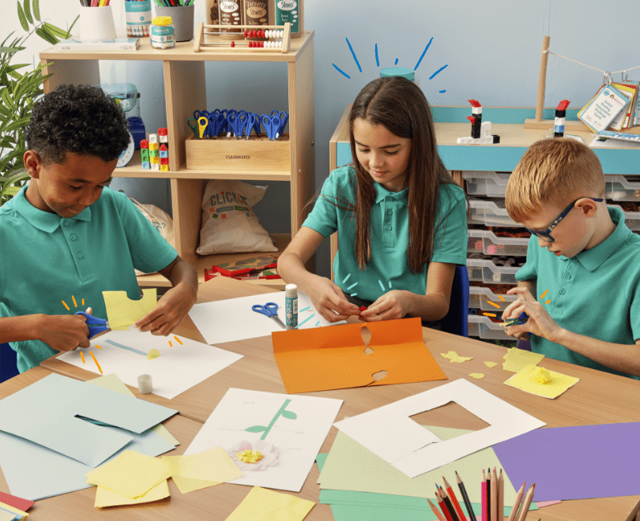
Author Lindsay Robinson
Lindsay Robinson has been a primary school teacher for 23 years and is passionate about achieving the very best outcomes for children through quality first teaching and experiences.
I remember receiving very little guidance during my teacher training to prepare me for the challenges I would face when teaching children with SEND (Special Educational Needs and Disabilities) in my mainstream school. Even today, I don’t think there could possibly be enough training to prepare teachers until they are actually faced with supporting the children in their own classes, and yet the 2014 ‘The Children and Families Act’ made it clear that most pupils with SEND would be taught in a mainstream school, and that every teacher is a teacher of SEND – not just the SENDCO or a teacher within specialist provision. This is certainly a challenge; however, I have found that the best way to create a positive SEND-friendly environment, is to simply look at the child in front of you, and work to meet their individual needs. No two children with SEND are the same; therefore, it’s important to think about how we can promote equity in our classrooms or – more simply – how we can provide all children with the resources and support they need to overcome any barriers to learning. With this in mind and an awareness of the types of challenges that may be faced, a few adaptations in our classrooms can benefit all children with SEND (including those with an EHCP) in order to provide the very best education, support and care that we can. With an understanding and awareness of each child’s needs comes the ability to help them succeed and we can create an environment where differences are celebrated. In my experience, nothing is more rewarding!
Well-being and Relationships
Research suggests that the behaviour and practice of the classroom teacher has the greatest impact on the academic and social outcomes of young people with SEND (Efthymiou & Kington, 2017) so it’s important to communicate with children in a way that supports their well-being at all times. The Anti-Bullying Alliance (All Together Report) found that children with SEND – particularly those with autism- report higher instances of bullying; therefore, we must promote and facilitate positive relationships with all the children in our classes. Supporting children with social skills and friendships is very important. You might want to consider these interventions:
A Whole Class Feelings Board
Most children with SEND respond well to visual adaptations. Having a whole-class board where children can attach a feelings picture (e.g. happy, calm, tired, sad) can be really helpful as it allows children to become more aware of their own feelings – particularly useful for children with SEMH (social, emotional, and mental health) challenges. It also helps the teacher and teaching assistants’ awareness so they can adapt their practice in response.
Understanding Feelings Picture Cards
Feelings Register
In my Year 6 classroom, we link the feelings board to a feelings register, where the children register their emotions into three numbered groups during the register in the morning.
1 – happy, calm, feeling ok, ready to learn
2 – frustrated, worried
3 – angry, terrified, very sad
It’s a quick way to understand how the children are feeling and adapt my practice where I need to. For example, if a child is at number 2, I will try to have a quick chat to them. If they are at 3, I will signpost a learning mentor or teaching assistant to give the child some time. This is also a good way to track children overtime in order to identify who might need some small group intervention; this can help children with communication and interaction and social, emotional, and health difficulties to learn how to identify their feelings and self-regulate.
Resources for Well-Being and Relationships Interventions:
Learn Well Feelings and Photographs Laminated Card Set
LEGO Therapy
LEGO therapy promotes social interaction, turn-taking skills, sharing and collaborative problem-solving. It was originally developed to support autistic children but has been proven to be beneficial for all children with neurodivergence. This can be used as a small intervention group and can support the SEND children (as well as others) in your class with social skills.
See Using LEGO Therapy with Autistic Pupils for more information.
Communication with the child, their parents and other adults in the school
The Child
Children with SEND can struggle with communication and this can not only be a barrier to learning but can also, in some cases, result in behaviour issues. I try to remember that behaviour is a form of communication so what is the behaviour that the child is presenting telling me about what they need? It’s helpful to give children the tools to be able to communicate with you effectively, thus removing this barrier. These strategies are helpful:
- Give the child a way to signal if they don’t understand or need a brain-break. This could be a card that they turn over on their desk or a simple hand gesture.
These emotions fans are very useful. LDA Emotions Fans
These fans provide the child with a simple visual signal. LDA Self-Assessment Fans
- Keep instructions clear and concise and chunk instructions into small steps.
- Model the task before expecting the children to complete it.
- Provide visuals to support instructions – these could be symbols, images, word banks etc.
Parents
There is a statutory duty to report to parents of pupils with SEND at regular intervals on progress and targets. Nevertheless, the most valuable communication is less formal and more regular. Simply providing parents with a home-school diary can be so helpful: after all, parents know their own child better than anyone.
Colleagues
A consistency of approach is so important for children with SEND. Communicating with other teachers and teaching assistants and sharing successes (and failures) when working with specific children is really valuable to build on and continue success. Teaching assistants should be part of the continual planning and evaluation process.
The SEND-Friendly Classroom Environment
Classroom Organisation
The organisation of the classroom environment is essential to children with SEND. Careful consideration of the space can remove barriers to learning and provides a calm, purposeful space to learn: remember that a classroom designed for a child with SEND is a great environment for all learners. Here are some considerations that I’ve found helpful:
- Keep displays simple with not too many overhanging decorations or bright, clashing colours – this can prevent autistic children or those with sensory issues from being visually overloaded.
- Avoid black and white presentations – this can support children with dyslexia.
- Display a visual timetable – autistic children and those with anxiety disorders can benefit from this.
- Using visuals for classroom organisation – this will help scaffold spoken instructions.
- Make a space available for learners to use when they need it – this can help support children with neurodivergence by providing them with a quiet space.
Classroom Equipment
The provision of equipment can remove some of the barriers to learning that children with SEND can face. This might be as simple as providing manipulatives such as place value counters or Numicon for a maths activity or it might be something designed specifically to support neurodivergence. Here are some examples of equipment that can support equity within the primary classroom:
Pencil grips – dyspraxia and motor-control
Wobble Cushion – ADHD and sensory needs
Ear Defenders – ADHD and sensory needs
Browse the full Hope Education SEND range of resources
Quality First Teaching (QFT)
High quality SEND teaching is absolutely high-quality teaching for all! When an adaptation is added to your teaching to support a SEND child, it will undoubtedly support many others within your classroom too:
Flexible Grouping
Plan groupings ahead using your knowledge of the strengths of your class and the barriers to learning in a particular area. Be flexible with these groupings by responding to the children within the lesson and mixing groupings up to provide support where needed.
Cognitive and Metacognitive Strategies
Managing cognitive load is something children with SEND can struggle with. Starting each lesson with a short retrieval practice activity on learning from a previous lesson and having the children evaluate their learning at the end of a lesson or unit can help with transferring new content into students’ long-term memory.
Explicit Instruction
Chunking instructions into small, manageable chunks; providing a ‘now do this… then….’ Board, using visuals and teacher modelling are all strategies to support explicit instruction.
Using Technology to Support Pupils with SEND
You might consider using speech recognition software; electronic magnifiers; text-to-speech aids or software; or adapted work with large fonts or particular colours.
Talking Tins
Recordable Card
Finger Focus Highlighters
LDA Reading Overlays – Coloured
Scaffolding
Teacher modelling under the visualiser or using it to address a misconception; providing word banks with visuals; and writing frames are some examples of scaffolds that you might find helpful.
A couple of key principles to keep in mind when trying to create a SEND-friendly classroom are that one child with SEND is unlike any other child with SEND; what worked well for one child may not work for another so the key is to get to know your children well; evaluate their responses and adapt accordingly. Most importantly, a SEND friendly classroom is a great classroom for all children to be part of – let’s celebrate the fact that we are all different and promote inclusivity and equity within our classrooms!
Lindsay Robinson has been a primary school teacher for 23 years and is passionate about achieving the very best outcomes for children through quality first teaching and experiences. She strives to make her classroom a nurturing and caring environment. As an author for Hope Education, Lindsay enjoys drawing upon her own experiences in the classroom to support and encourage other teachers in their own classrooms.
All of the resources recommended can be found at hope-education.co.uk. Hope is rated Excellent on Trustpilot and offers Free Next Day Delivery. Hope has won many awards for the best service in the industry making Hope their customers’ Undisputed First Choice Education Resource Supplier. Part of the Findel family and home to EuHu – the Educator Hub created by teachers for teachers, Hope understands educators’ challenges and exists to make each day that little bit easier. For everything you could need each day, with value, service and quality you really want, Hope is all you need. *Full Terms and Conditions and latest prices and promotions are available online too. Primary School & Early Years Teaching Resources | Hope Education (hope-education.co.uk).


